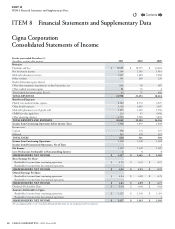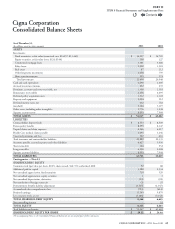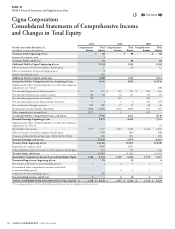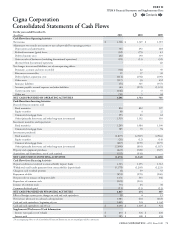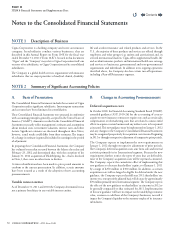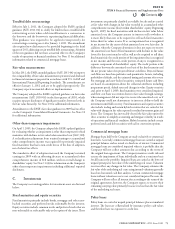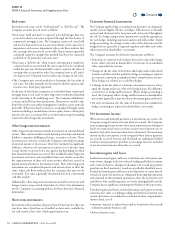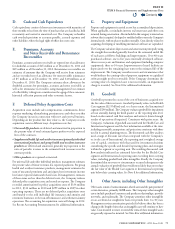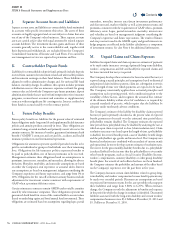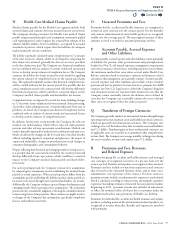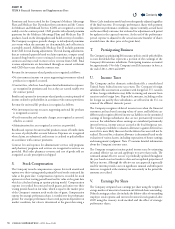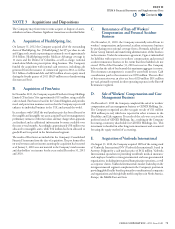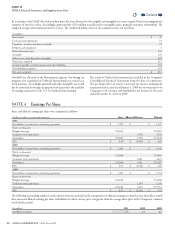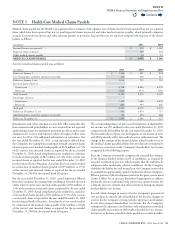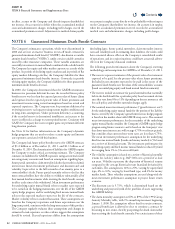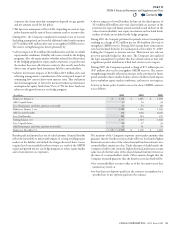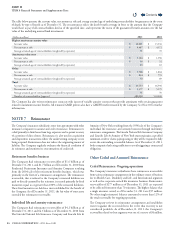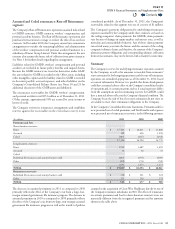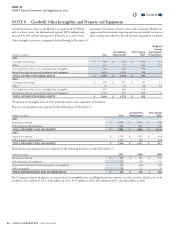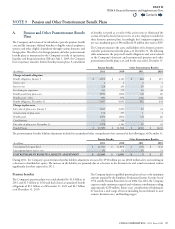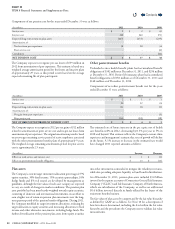Cigna 2011 Annual Report Download - page 100
Download and view the complete annual report
Please find page 100 of the 2011 Cigna annual report below. You can navigate through the pages in the report by either clicking on the pages listed below, or by using the keyword search tool below to find specific information within the annual report.
78 CIGNA CORPORATION2011 Form10K
PART II
ITEM 8 Financial Statements and Supplementary Data
Premiums and fees received for the Company’s Medicare Advantage
Plans and Medicare PartD products from customers and the Centers
for Medicare and Medicaid Services (CMS) are recognized as revenue
ratably over the contract period. CMS provides risk adjusted premium
payments for the Medicare Advantage Plans and Medicare PartD
products, based on the demographics and health severity of enrollees.
e Company recognizes periodic changes to risk adjusted premiums
as revenue when the amounts are determinable and collection is
reasonably assured. Additionally, Medicare PartD includes payments
from CMS for risk sharing adjustments. e risk sharing adjustments,
that are estimated quarterly based on claim experience, compare actual
incurred drug benet costs to estimated costs submitted in original
contracts and may result in more or less revenue from CMS. Final
revenue adjustments are determined through an annual settlement
with CMS that occurs after the contract year.
Revenue for investment-related products is recognized as follows:
•
Net investment income on assets supporting investment-related
products is recognized as earned.
•
Contract fees, which are based upon related administrative expenses,
are recognized in premiums and fees as they are earned ratably over
the contract period.
Benets and expenses for investment-related products consist primarily of
income credited to policyholders in accordance with contract provisions.
Revenue for universal life products is recognized as follows:
•Net investment income on assets supporting universal life products
is recognized as earned.
•
Fees for mortality and surrender charges are recognized as assessed,
which is as earned.
•Administration fees are recognized as services are provided.
Benets and expenses for universal life products consist of benet claims
in excess of policyholder account balances. Expenses are recognized
when claims are submitted, and income is credited to policyholders
in accordance with contract provisions.
Contract fees and expenses for administrative services only programs
and pharmacy programs and services are recognized as services are
provided. Mail order pharmacy revenues and cost of goods sold are
recognized as each prescription is shipped.
S. Stock Compensation
e Company records compensation expense for stock awards and
options over their vesting periods primarily based on the estimated fair
value at the grant date. Compensation expense is recorded for stock
options over their vesting period based on fair value at the grant date
which is calculated using an option-pricing model. Compensation
expense is recorded for restricted stock grants and units over their
vesting periods based on fair value, which is equal to the market price
of the Company’s common stock on the date of grant. Compensation
expense for strategic performance shares is recorded over the performance
period. For strategic performance shares with payment dependent on
market condition, fair value is determined at the grant date using a
Monte Carlo simulation model and not subsequently adjusted regardless
of the nal outcome. For strategic performance shares with payment
dependent on performance conditions, expense is initially accrued based
on the most likely outcome, but evaluated for adjustment each period
for updates in the expected outcome. At the end of the performance
period, expense is adjusted to the actual outcome (number of shares
awarded times the share price at the grant date).
T. Participating Business
e Company’s participating life insurance policies entitle policyholders
to earn dividends that represent a portion of the earnings of the
Company’s life insurance subsidiaries. Participating insurance accounted
for approximately 1% of the Company’s total life insurance in force at
the end of 2011,2010 and 2009.
U. Income Taxes
e Company and its domestic subsidiaries le a consolidated
UnitedStates federal income tax return. e Company’s foreign
subsidiaries le tax returns in accordance with foreign law. U.S. taxation
of these foreign subsidiaries may dier in timing and amount from
taxation under foreign laws. Reportable amounts, including credits
for foreign tax paid by these subsidiaries, are reected in the U.S. tax
return of the aliates’ domestic parent.
e Company recognizes deferred income taxes when the nancial
statement and tax-based carrying values of assets and liabilities are
dierent and recognizes deferred income tax liabilities on the unremitted
earnings of foreign subsidiaries that are not permanently invested
overseas. For subsidiaries whose earnings are considered permanently
invested overseas, income taxes are accrued at the local foreign tax rate.
e Company establishes valuation allowances against deferred tax
assets if it is more likely than not that the deferred tax asset will not be
realized. e need for a valuation allowance is determined based on the
evaluation of various factors, including expectations of future earnings
and management’s judgment. Note19 contains detailed information
about the Company’s income taxes.
e Company recognizes interim period income taxes by estimating
an annual eective tax rate and applying it to year-to-date results. e
estimated annual eective tax rate is periodically updated throughout
the year based on actual results to date and an updated projection of
full year income. Although the eective tax rate approach is generally
used for interim periods, taxes on signicant, unusual and infrequent
items are recognized at the statutory tax rate entirely in the period the
amounts are realized.
V. Earnings Per Share
e Company computes basic earnings per share using the weighted-
average number of unrestricted common and deferred shares outstanding.
Diluted earnings per share also includes the dilutive eect of outstanding
employee stock options and unvested restricted stock granted after
2009 using the treasury stock method and the eect of strategic
performance shares.
Contents
Q


